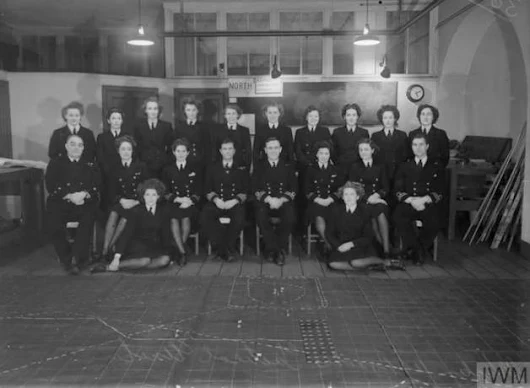occurred during WW2. The
(Britain in particular) and Germany tried to gain a monopoly on weather data in the
.
. In some circumstances, visibility was necessary (photographic reconnaissance and bombing raids) and in others concealment (keeping ship movements secret or suppressing enemy air activity).
; it was delayed by one day in the expectation that a storm would blow out and sea conditions would be acceptable. British sources of data included ships at sea and the weather stations at
codes.
https://en.wikipedia.org/wiki/North_Atlantic_weather_war .
Weather Station Kurt (
Wetter-Funkgerät Land-26) was an
automatic weather station, erected by a German
U-boat crew in
northern Labrador,
Dominion of Newfoundland in
October 1943. Installing the equipment for the station was the only known armed German military operation on land in North America during the
Second World War. After the war it was forgotten until its rediscovery in 1977.
Weather systems in
temperate climates predominantly move from west to east. This gave the
Allies an important advantage. The
Allied network of weather stations in
North America, Greenland, and Iceland allowed the Allies to make
more accurate weather forecasts than the Germans. German meteorologists had weather reports sent by U-boats and
weather ships, such as
Lauenburg, operating in the North Atlantic. They also had reports from
clandestine weather stations in remote parts of the
Arctic and readings collected over the Atlantic by
specially equipped weather aircraft. However, the ships and clandestine stations were easily captured by the Allies during the early part of the war. Data from aircraft was incomplete as they were limited in range and susceptible to Allied attack. Regular weather reporting by U-boats put them at risk as it broke
radio silence, allowing the Allies to locate them and track their movements by
radio triangulation.
To gather more weather information, the
Germans developed the Wetter-Funkgerät Land (WFL) automatic weather station. It was designed by Dr. Ernst Ploetze and Edwin Stoebe. Twenty-six were manufactured by
Siemens. The WFL had an array of measuring instruments, a
telemetry system and a 150 watt, Lorenz 150 FK-type
transmitter. It consisted of
ten cylindrical canisters, each 1 metre (3.3 ft) by c.47 cm diameter (1.5 metres (4.9 ft) circumference) and weighing around 100 kilograms (220 lb). One canister contained the instruments and was attached to a
10-metre (33 ft) antenna mast. A second, shorter mast carried an
anemometer and
wind vane. The other canisters contained the
nickel-cadmium batteries that powered the system. The WFL would send weather readings every three hours during a two-minute transmission on 3940 k
Hz. The system could
work for up to six months, depending on the number of battery canisters.
Fourteen stations were deployed in Arctic and sub-Arctic regions (Greenland,
Bear Island,
Spitsbergen, and
Franz Josef Land) and five were placed around the Barents Sea. Two were intended for North America. One was deployed in 1943 by the
German submarine U-537, but the submarine carrying the other,
U-867, was sunk in September 1944 northwest of
Bergen, Norway, by a British air attack.
[1]
On
September 18, 1943,
U-537, commanded by Kapitänleutnant Peter Schrewe, departed from
Kiel, Germany on her first combat patrol. She carried WFL-26, codenamed "Kurt", a meteorologist, Dr. Kurt Sommermeyer, and his assistant, Walter Hildebrant. En route, the U-boat was caught in a storm and a large breaker produced significant damage, including leaks in the hull and the loss of the submarine's quadruple
anti-aircraft cannon, leaving it both unable to dive and defenceless against Allied aircraft.
On October 22, U-537 arrived at Martin Bay in Northern Labrador, at a position
60°5′0.2″N 64°22′50.8″WCoordinates:
 60°5′0.2″N 64°22′50.8″W
60°5′0.2″N 64°22′50.8″W.
[3] This is close to
Cape Chidley at the
north-eastern tip of the Labrador Peninsula. Schrewe selected a site this far north as he believed this would minimize the risk of the station being discovered by
Inuit people. Within an hour of dropping anchor, a scouting party had located a suitable site, and soon after Dr. Sommermeyer, his assistant, and ten sailors disembarked to install the station. Armed lookouts were posted on nearby high ground, and other crew members set to repair the submarine's storm damage.
For concealment, the
station was camouflaged.
Empty American cigarette packets were left around the site to deceive any Allied personnel that chanced upon it, and the
equipment was marked as the property of the non-existent "Canadian Meteor Service" (at the time, the area was part of the
Dominion of Newfoundland and
not part of Canada until 1949). The crew worked through the night to install Kurt and repair their U-boat. They finished just 28 hours after dropping anchor and, after confirming the station was working, U-537 departed. The
weather station functioned for only a month before it
permanently failed under mysterious circumstances, possibly because its radio transmissions were jammed. The
U-boat undertook a combat patrol in the area of the
Grand Banks of Newfoundland, during which she survived three attacks by Canadian aircraft, but sank no ships. The submarine reached port at
Lorient, France on December 8, after seventy days at sea. She was
sunk with all hands eleven months later on
November 11, 1944 by the submarine
USS Flounder near the
Dutch East Indies.
https://en.wikipedia.org/wiki/Weather_Station_Kurt .
https://www.warhistoryonline.com/world-war-ii/weather-station-kurt.html .
https://ww2db.com/battle_spec.php?battle_id=328 .
..



